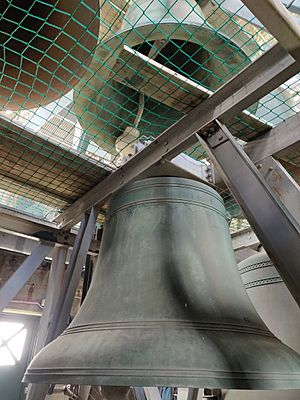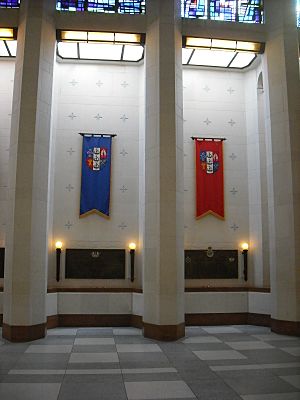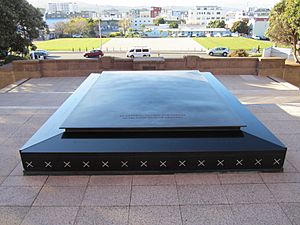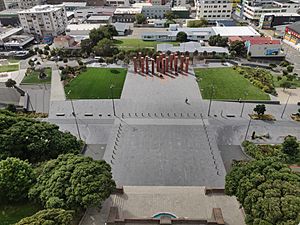National War Memorial (New Zealand) facts for kids
Quick facts for kids National War Memorial |
|
|---|---|
| New Zealand | |
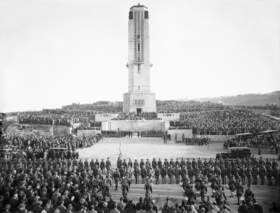
The dedication of the National War Memorial Carillon, on Anzac Day, 25 April 1932
|
|
| For New Zealand dead of South African War, World Wars I and II and the wars in Korea, Malaysia and Vietnam | |
| Unveiled | Anzac Day 1932 |
| Location | 41°17′56.67″S 174°46′37.80″E / 41.2990750°S 174.7771667°E Wellington, New Zealand
|
| Designed by | Gummer and Ford |
The National War Memorial is a special place in Wellington, New Zealand's capital city. It stands next to the New Zealand Dominion Museum building on Buckle Street. This memorial was opened on Anzac Day in 1932. It was built to remember New Zealanders who died in the First World War. It also honors those who lost their lives in the South African War, World War II, and the wars in Korea, Malaysia, and Vietnam.
The National War Memorial has three main parts. There's the War Memorial Carillon, which is a musical instrument with many bells. There's also the Hall of Memories, a quiet place for reflection. Finally, there's a special tomb for an unknown New Zealand warrior. This tomb was built in 2004.
Inside the memorial, you can find four special lists called Rolls of Honour. These lists have the names and ranks of 28,654 New Zealanders. A bronze statue of a family group, made by Lyndon Smith, is a key feature here. About 20,000 people visit the memorial each year.
Contents
- The War Memorial Carillon: A Giant Musical Instrument
- Hall of Memories: A Place to Remember
- Unknown Warrior: A Symbol for All
- The Man with the Donkey: A Tribute to Medical Heroes
- History of the Memorial
- Pukeahu National War Memorial Park
- Images for kids
The War Memorial Carillon: A Giant Musical Instrument
The National War Memorial Carillon is like a sister instrument to a similar carillon in Ottawa, Canada. That one has 53 bells.
The bells for New Zealand's carillon were made in Croydon, England, by a company called Gillett & Johnston. They arrived in New Zealand in January 1931.
Each of the first 49 bells has a name or message on it. These messages remember people who served in the war. The three biggest bells are named "Anzac," "Somme," and "Palestine." These were important places where New Zealand soldiers fought. Other bells include "The Nurses bell," "The Gallipoli 1915 bell," and "The Medical forces bell." There's even a "Flanders field bell" that remembers Leslie Beauchamp, the brother of writer Katherine Mansfield. One bell, the "Wellington’s South African War Veterans’ bell," was added later.
When the carillon first opened, its 49 bells varied greatly in size. The smallest bell weighed just over 4 kg. The largest bell weighed 5 tonnes and was 2 meters tall. All the bells together weighed more than 30 tonnes. They cost about £11,000 at the time.
The memorial building uses a lot of New Zealand stone. The carillon was first covered with a pinkish-brown stone from Putaruru. Sadly, this stone didn't last well in the weather. So, in 1982, it was replaced with Takaka marble.
Since 1984, the Carillon has been rebuilt and made much bigger. Twenty middle-sized bells were replaced. Now it has 21 smaller bells and 4 large bass bells. This means it can play a wider range of notes. The four new bass bells were added in 1995. They are named "Grace/Aroha," "Hope/Tūmanako," "Remembrance/Whakamaharatanga," and "Peace/Rangimārie." Today, the Carillon has 74 bells. The "Peace/Rangimārie" bell is the heaviest, weighing 12.5 tonnes. This makes it the largest bell in the Southern Hemisphere. The Carillon is the third largest in the world by total weight.
The Carillon is played for over 200 hours of live concerts each year. Special concerts happen on Anzac Day and for other battle anniversaries. There's also a program to teach people how to play the carillon. Only four official carillonists have played here since 1932: Gladys Watkins, John Randal, Selwyn Baker, and Timothy Hurd.
Hall of Memories: A Place to Remember
You enter the Hall of Memories through a round room at the bottom of the Carillon Tower. Inside, there are six special areas on each side. These lead to a main area called the Sanctuary at the far end. These areas are like small chapels. They are dedicated to the different parts of the New Zealand Armed Forces that have served in wars overseas.
At the entrance to the Sanctuary, there are two white stone columns. Each column has a bronze ball and cross on top. They are carved with the symbols of countries from the Commonwealth. These countries fought alongside New Zealand in World War I and II. The symbols are connected by branches, showing how the Commonwealth is linked. On the two side walls of the Sanctuary, large crosses are carved. These crosses have the symbols of the main towns from New Zealand's nine provinces. They remind us of the sacrifices New Zealanders made in wartime.
A special light called the Lamp of Brotherhood is also in the Sanctuary. This lamp is one of 84 made after World War II. They were created to remember all war dead and to encourage peace between nations.
The four Rolls of Honour, with names and ranks of fallen New Zealanders, are in bronze display cases. You can find them on the east and west walls of the Sanctuary.
The Hall of Memories is lined with cream-colored Mt Somers stone. Other stones like Hanmer marble, Coromandel granite, and Takaka marble are also used inside.
Unknown Warrior: A Symbol for All
The Unknown Warrior symbolise[s] the tremendous sacrifice New Zealand has made over the last century in the struggle to preserve freedom and justice and the democratic way of life...For all New Zealanders this [is] a day of remembrance and a day to remember.
In 2004, a special project brought home the body of an unknown soldier. This soldier was buried in a new tomb. This was done to create a central place to remember all New Zealand servicemen and women who sacrificed their lives.
This Unknown Warrior is one of over 250,000 New Zealanders who served in wars overseas. He is one of 30,000 who died while serving. He is also one of over 9,000 who have no known grave. His remains were chosen from the Caterpillar Valley Cemetery in France. This area is where the New Zealand Division fought in 1916.
Because the soldier's name, rank, and other details are unknown, he represents all New Zealanders lost to their families in war.
I told him [the Warrior] we're taking him home and that those who are taking him home are soldiers, sailors and airmen, past and present. I asked the Warrior to be the guardian of all military personnel who had died on active service. I then promised that we, the people of New Zealand, will be his guardian
On November 1, 2004, a New Zealand group traveled to France. They went to bring the Unknown Warrior's remains home. A special ceremony took place on November 6 at the New Zealand Memorial site in Longueval, France. This ceremony officially handed the Unknown Warrior from the Commonwealth War Graves Commission back to New Zealand.
When the Unknown Warrior returned to New Zealand on November 10, he lay in state at Parliament. Thousands of New Zealanders came to pay their respects. A memorial service was held on November 11 at Wellington Cathedral of St Paul. After that, a military funeral procession marched through central Wellington. More than 100,000 people lined the streets to the National War Memorial. There, an interment ceremony with full military honors took place.
The Warrior was finally laid to rest in the Tomb of the Unknown Warrior on Thursday, November 11, 2004, which is Armistice Day.
The Tomb is sealed with a bronze plate. It says:
An Unknown New Zealand Warrior
He Toa Matangaro No Aotearoa
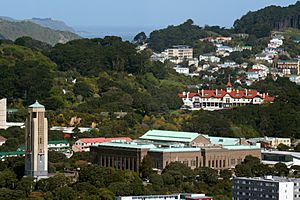
The Man with the Donkey: A Tribute to Medical Heroes
A bronze statue called "The Man with the Donkey" stands outside the National War Memorial. It was created by Paul Walshe. The statue shows Richard Alexander Henderson. It is based on a famous photo taken at Gallipoli in 1915. This statue honors all medical staff, stretcher bearers, and ambulance drivers who helped New Zealand troops in wartime. The Royal New Zealand Returned and Services’ Association asked for this statue to be made. Henderson's son, Ross, unveiled it in 1990.
History of the Memorial
In 1919, the New Zealand Government decided to spend £100,000 on a National War Memorial in Wellington. After much discussion, they agreed to build a complex. It would include a national art gallery, a museum, and the war memorial with a carillon. This complex would be in the central suburb of Mt Cook. In 1929, a competition was held for the designs. The firm Gummer and Ford won the competition.
The foundation stone of the memorial has a special message. It says:
REO WAIRUA. TO THE GLORY OF GOD. To the memory of the New Zealander that died in the Great War, 1914 to 1918, and in honour of those that served or suffered, this stone was laid by the Right Honourable G W Forbes, PC, MP, Prime Minister of New Zealand, on 15th May, 1931.
The main work was finished for Anzac Day 1932. The Governor-General, Lord Bledisloe, turned on the Lamp of Remembrance at the top of the tower. Newspapers reported hearing "magic from the skies."
The museum opened in 1936, but the Hall of Memories was delayed. First, there was the Great Depression, then World War II. Plans for the Hall were made in 1937 and again in 1949. But building didn't start until 1960. The Christchurch company P Graham and Son, who built the carillon tower, won the bid to build the Hall. Their offer was £114,000.
The Hall of Memories was officially opened on April 5, 1964. The Governor-General, Sir Bernard Fergusson, opened it.
By the late 1950s, the Putaruru stone on the Carillon was in bad shape. Repairs were approved as part of the Hall of Memories project. But work didn't begin until 1981-82. Parts of the tower were replastered. Canaan marble replaced the old stone. Metal parts like louvres and window frames were also replaced.
In 1985, the Carillon was restored and now had 65 bells. It was ready to be rededicated in 1986. Queen Elizabeth II was there for the ceremony.
The unknown New Zealand warrior was added in 2004. It took a long time to happen. Army Colonel Andrew Renton-Green explained why. The original design for the memorial in 1932 included a tomb. But building stopped because of the Depression. So, the idea was put on hold. In 1963, the Hall of Memories was added. That's when people like the RSA (Returned and Services' Association) thought it would be good to have their own Unknown Warrior. Many New Zealanders couldn't travel to Westminster Abbey in London to visit the Commonwealth tomb.
It took another 40 years for the government to act. Prime Minister Helen Clark helped make it happen. There was a competition for the tomb's design. The final design, simple and classic, was created by Kingsley Baird. It uses bronze and stone and is set into the steps below the memorial.
Colonel Renton-Green said that the memorial is a "living thing." It's not just about people who have died. It's about living people too.
In February 2020, the National War Memorial Building was closed to the public. This was due to worries about how well it would stand up in an earthquake.
Pukeahu National War Memorial Park
Pukeahu National War Memorial Park, also known as Pukeahu Park, opened on April 18, 2015. This was just in time for the 100th anniversary of the World War I Gallipoli landings. It was a major project by the New Zealand Government to remember the First World War's 100th anniversary.
In May 2004, Prime Minister Helen Clark said that a park would make the area even better. It would give a more fitting setting for New Zealand's memorial to those who died in wars. She noted that important parts of New Zealand's history and identity were formed during difficult times of conflict. This is shown by the increasing number of people who attend Anzac Day services.
Arras Tunnel: A Road Under the Park
In 2005, the Ministry for Culture and Heritage worked with the New Zealand Transport Agency. They bought land in front of the National War Memorial to create a National Memorial Park. In August 2012, the government announced a big change. Part of State Highway 1 would go underground. It would be in a tunnel beneath the Park. This allowed the park to stretch over the old road, creating one big memorial area.
The tunnel opened on September 29, 2014. It was named Arras Tunnel. Inside, there are 273 decorative red poppies. These remind drivers that they are passing through a special memorial space. Arras Tunnel was named to honor the New Zealand Tunnelling Company. They worked in the French town of Arras during the Great War.
Artworks, Memorials and Sculptures: Remembering Together
The park has memorials from both New Zealand's military friends and even former opponents.
Australian Memorial
The Australian memorial remembers the strong military friendship between Australia and New Zealand. It was designed by Australian architects. The memorial has fifteen red sandstone columns. They have carvings and artworks by both Aboriginal and Māori artists. The memorial was opened in April 2015 by the Prime Ministers of Australia and New Zealand.
Belgian Memorial
The Belgian memorial was designed by Belgian artists. It is made of steel. The sculpture combines a laurel wreath, a symbol of victory, with a memorial wreath. This honors those who died in battle. A similar sculpture is in Belgium. Belgian officials attended ceremonies for the memorial. Soil from Belgium was placed into the ground.
French Memorial
The French Memorial, called "Le Calligramme," was unveiled in May 2018. It features words from a 1915 poem by French soldier Guillaume Apollinaire. The memorial uses local stone and crushed French stone from the Western Front.
German Tapestry
In November 2017, the President of Germany unveiled a memorial tapestry. It was a gift from Germany. The tapestry is called 'Flandern'. It is based on a photo of a World War I battlefield. The artist said it reminds us of the "misery and horror" of war.
Pacific Islands Memorial
A memorial honoring Pacific islanders who served in wars was opened in March 2021. It specifically remembers overseas soldiers and the Coastwatchers. The memorial is called Te Reo Hotunui o te Moana-nui-a-Kiwa. This means The Deep Sigh of the Pacific. It has a large bronze sculpture of a conch shell with remembrance poppies. The artist was Michel Tuffery. The sculpture was inspired by a conch shell found in a World War I tunnel in Arras, France. A Cook Islander soldier had carved his name on it. The prime ministers of New Zealand and the Cook Islands attended the dedication. They both called for more recognition of Pacific islanders' military service.
Turkish Memorial
This memorial was unveiled in March 2017. It has a bronze plaque with words of peace often said by Mustafa Kemal Atatürk. Behind the plaque, there is a Turkish red pine tree. This tree is a descendant of the original Lone Pine at Gallipoli. The memorial was designed by New Zealand artist and Army Gunner Matt Gauldie.
United Kingdom Memorial
In July 2017, the United Kingdom Memorial was unveiled by Boris Johnson. It was designed by Weta Workshop with help from students.
The design shows two important trees: a Royal Oak from the UK and a Pōhutakawa from New Zealand. Their trunks twist together to form one leafy top. Leaves from both trees mix, creating a feeling of shelter. This is why the memorial is called Whakaruruhau, which means shelter. Standing at the plaque, you can see a silhouette of a soldier. This represents the two countries standing together and the millions who served in times of conflict and peace.
United States of America Memorial
On December 10, 2018, the U.S. Memorial was unveiled. It shows the shared history of the United States and New Zealand. It has a granite tablet with words from a radio speech. This speech was given on Anzac Day 1943 by the US Secretary of the Navy Frank Knox. It says:
Together, in our strength, we shall keep that ocean – Pacific! ... As we are comrades in battle, so we shall be partners in victory. I salute the lands of the ANZACs as our companions in the peace that will follow, comrades and partners as an example to all the world of what can be accomplished by a fraternity of free men.
1918 Influenza Pandemic Memorial Plaque
On November 6, 2019, a memorial plaque was unveiled at Pukeahu. It remembers the victims of the 1918 Influenza Pandemic. This pandemic killed about 9,000 New Zealanders. The plaque was designed by Neil Pardington and Wraight & Associates. It was unveiled by Prime Minister Jacinda Ardern and historian Geoffrey Rice.
Awards
The Pukeahu National War Memorial Park has won several awards:
- New Zealand Indigenous and Specialty Timber Award - Resene Timber Design Awards 2015
- Public Architecture Award - New Zealand Architecture Awards 2016
- George Malcom Award - New Zealand Institute of Landscape Architects 2017
Images for kids
-
The dedication of the National War Memorial Carillon, on Anzac Day, 25 April 1932


